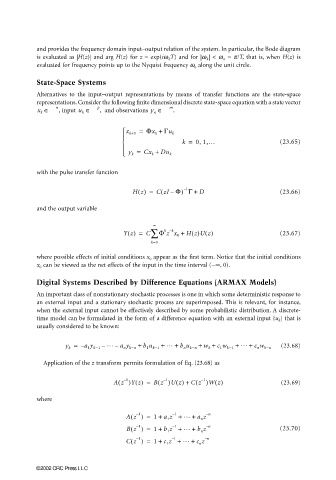Page 726 - The Mechatronics Handbook
P. 726
0066_Frame_C23 Page 34 Wednesday, January 9, 2002 1:55 PM
and provides the frequency domain input–output relation of the system. In particular, the Bode diagram
is evaluated as |H(z)| and arg H(z) for z = exp(iω k T) and for |ω k | < ω n = π/T, that is, when H(z) is
evaluated for frequency points up to the Nyquist frequency ω n along the unit circle.
State-Space Systems
Alternatives to the input–output representations by means of transfer functions are the state-space
representations. Consider the following finite dimensional discrete state-space equation with a state vector
x k ∈ , input u k ∈ , and observations y n ∈ .
p
n
m
x k+1 = Φx k + Γu k
k = 0, 1,… (23.65)
y k = Cx k + Du k
with the pulse transfer function
(
Hz() = CzI Φ) Γ + D (23.66)
–
1
–
and the output variable
∞
Yz() = C ∑ Φ z x 0 + Hz()Uz() (23.67)
k –
k
k=0
where possible effects of initial conditions x 0 appear as the first term. Notice that the initial conditions
x 0 can be viewed as the net effects of the input in the time interval (−∞, 0).
Digital Systems Described by Difference Equations (ARMAX Models)
An important class of nonstationary stochastic processes is one in which some deterministic response to
an external input and a stationary stochastic process are superimposed. This is relevant, for instance,
when the external input cannot be effectively described by some probabilistic distribution. A discrete-
time model can be formulated in the form of a difference equation with an external input {u k } that is
usually considered to be known:
y k = – a 1 y k−1 – … – a n y k−n + b 1 u k−1 + … + b n u k−n + w k + c 1 w k−1 + … + c n w k−n (23.68)
Application of the z transform permits formulation of Eq. (23.68) as
1
–
(
1
Az ( – 1 )Yz() = Bz )Uz() + Cz )Wz() (23.69)
(
–
where
–
1
Az ( – 1 ) = 1 + a 1 z + … + a n z – n
Bz ( – 1 ) = 1 + b 1 z + … + b n z – n (23.70)
–
1
–
(
Cz ) = 1 + c 1 z + … + c n z – n
1
1
–
©2002 CRC Press LLC

